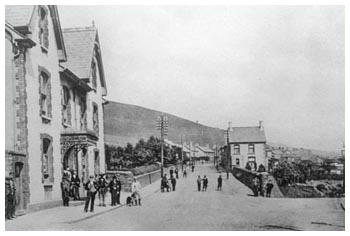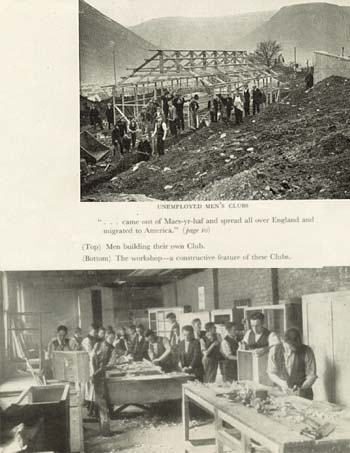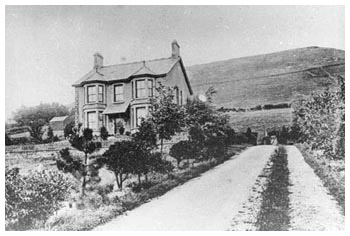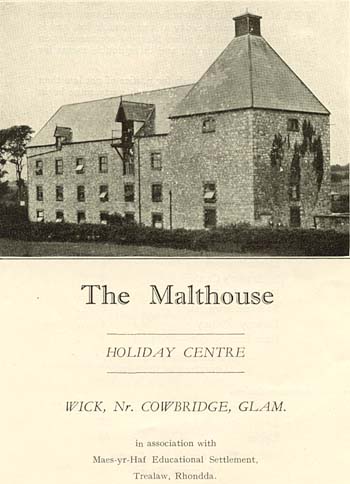
| Trealaw | |
Trealaw is said to have taken its name from one of the local landowner's, David Williams, bardic name of Alaw. Alaw itself derives from the Welsh word for either lily or melody or tune. The ownership and tenancies of Trealaw on the 1847 tithe maps clearly show the beginnings of coal exploration in the area. Although the executors of the Anne Sanderson Estate own the farms, such as Brithweunydd Isaf and Brithweunydd Uchaf, the tenant for these properties is listed as Walter Coffin the earliest pioneer of major coal mining in the lower Rhondda. In fact Coffin's leasing of land at Trealaw dates as far back as 1811, however he did not open his first level in this part of the valley until 1839, after his operations at Dinas were proved to be successful. The mining properties at Trealaw were subsequently sold to Daniel Thomas, who opened up the Brithweunydd Level to the steam coal measures in 1862. The colliery was eventually closed in 1879. |
|
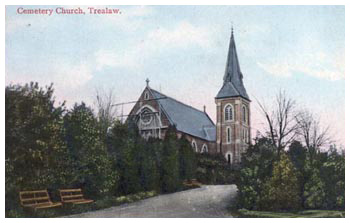 |
The expanding population of the Rhondda in the second half of the 1800's led the local district council to realise that existing cemetery provision was inadequate. As such a parcel of land was purchased on the mountainside at Trealaw, known as Llethr-Du, upon which was constructed a municipal cemetery and chapel. The first burial at the cemetery, also called Llethr-Ddu, was in 1881 and the chapel was completed in 1883. Left: Cemetery Church Trealaw |
An important part of Trealaw's history occurred in the 1920's with the founding of the ‘educational settlement' known as Maes-Yr-Haf. The driving forces behind the founding of this institution were Emma and William Noble and it was to play a vital role during the depression years in the Rhondda. As well as programmes of classes and lectures, it also provided a centre for material relief to try to alleviate some of the worst sufferings of residents of Trealaw and the Rhondda during those difficult times. It was here that the first ‘Unemployed Men's Clubs' were formed where those that were unemployed would gather to educate themselves and attempt to find alternate means of making a living. These clubs quickly spread throughout Britain and even to America during the Depression years |
The Royal Hotel Trealaw |
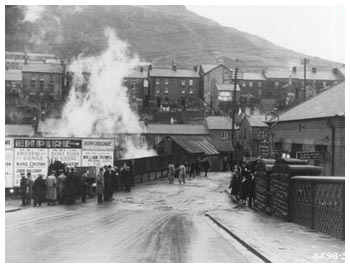 |
Trealaw also boasted the impressive building known as ‘Judge's Hall'. Known originally as, ‘The Judge Williams Memorial Hall', the building was officially opened in July 1909 by Princess Louise and The Duke of Argyll. The building was a gift to the residents of the area by Lt. Colonel Sir Rhys Williams and boasted a 1,500 capacity concert hall, as well as a library and billiard room.
Left: The Bridge Trealaw |
| MAES-YR-HAF TREALAW | |
| Today Maes-Yr-Haf serves as a community centre for the people of Trealaw hosting amongst others a playgroup, camera club, Rotary Club meetings as well as the meetings of the Quaker Society of Friends. Its origins however were as a unique social experiment based in the turbulent 1920's, an experiment whose results had implications throughout the depressed areas of Britain and indeed America of that time. An excellent history of the Maes-Yr-Haf settlement is outlined in a booklet produced for its twenty-fifth anniversary in 1952 written by William Hazelton, from which the following details were obtained. | |
| Origins | |
|
Britain in 1926 was undergoing an industrial crisis, which led to the calling of a General Strike in the May of the year in support of the miners. Although the strike was called off after nine days thousands of miners continued to strike in opposition to pay reductions. The Society of Friends (Quakers) annual meeting at Manchester that year held a debate on the situation and decided to send representatives to colliery districts. These representatives were to gather first hand information on the plight of these districts and ascertain the emergency needs of their people.One of the members of the Society present at the meeting was a young woman named Emma Noble who decided to travel to the Rhondda. |
| After the Strike | |
| By the end of 1926 the miners' strike was over and the miners went back to work defeated, however many thousands of miners were left unemployed. In January 1927 Emma Noble and others attended a meeting in Oxford convinced of the need for continuing aid to the deprived mining areas. At this meeting the first steps were taken to maintain and develop the spiritual and educational service alongside the practical social work provided in the Rhondda. As such a committee was formed and Emma and her husband William agreed to return to the Rhondda for a further two years and a house Maes- Yr -Haf was purchased as a base for the operations. The idea was for it to serve as a home for adult education, providing opportunities for discussion, teaching and study. It was seen as pioneer effort to meet the needs of, ‘a people whose sole occupation was coal mining and whose lives were darkened by the cloud of industrial depression and unemployment.' The centre was by its nature experimental and the committee left it up to the Nobles with their first hand knowledge and experience free, in most part, to develop the centre as they saw fit. From the outset the centre was intended to be ‘ a place of friendship, counsel and sympathy and practical helpfulness, of pioneering adult education in its broadest sense.' Although not intended to be a centre for material relief events in the valley and the scale of unemployment and deprivation suffered by its people did in fact lead Maes-Yr-Haf to become a centre for many kinds of material relief. | 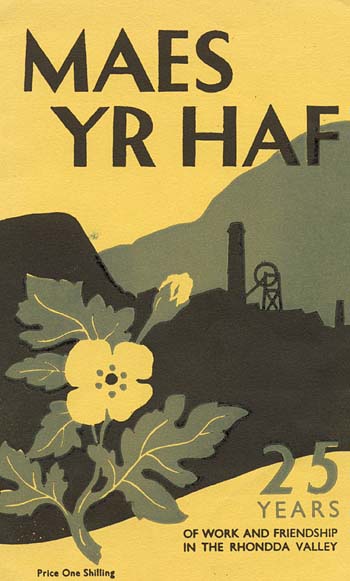 |
| Adult Education | |
Maes-Yr-Haf circa 1930 |
Between its formation in 1927 and 1939 more than 475 grant earning classes and courses of lectures were held at Maes-Yr-Haf, together with thousands of single lectures, for example in 1937-38 amongst many others the centre held courses in University tutorials, University preparatory courses, and University extension courses. These courses were run with the help of volunteers as well as the support of the University of Wales, the Workers Educational Association, the YMCA, the National Council of Music in Wales and the National Council of Social Service, and were undertaken at Maes-Yr-Haf as well as a number of subsidiary centres. Additionally innumerable informal groups and discussion circles as well as drama societies and choirs were formed at Maes-Yr-Haf and its outposts together with dressmaking classes, handicrafts, and Physical Training classes. |
| Unemployed Single Men | |
| By 1928 the valley was filled with a large number of destitute men who were unemployed and unable to claim benefit. As such the idea of Miners' Training or Occupational Clubs was pioneered at Maes-Yr-Haf. The idea was to provide each man with one days work each week at union rates of pay together with one hot meal every day and the use of the clubs facilities. The unemployed men worked on local parks and recreational grounds carrying out work arranged through local authorities and recreation committees. The work was of communal value and was of a nature that it would not be used to displace normal labour. There were club premises available in each of the local areas where members could partake of a hot meal and participate in physical fitness classes, gramophone recitals, concerts and lectures etc. In the summer each member was entitled to a weeks holiday at Maes-YrHaf's holiday centre by the sea. In total some 5,030 men benefited from these clubs, financed at first by the Society of Friends and latterly the Lord Mayor's Coalfield distress Fund. Which expanded this pilot scheme throughout the needy areas of South Wales. | |
| Unemployed Mens Clubs | |
| The success of this experiment for unemployed single men led to the formation in 1931 of the first Unemployed Mens Clubs, which were such a success they eventually were to be seen throughout Britain and even America. The premises for these clubs were at first makeshift, utilising disused building within the community, but as the movement grew many of the men erected their own buildings. By 1932 there were ten clubs with a membership of 1,500 this grew in the course of the next seven years to 60 clubs with a membership around 9,000. During this time of great unemployment clubs remained open all day providing unemployed men with a place where they could sit and read and socialise, and a place of warmth and shelter in the winter | 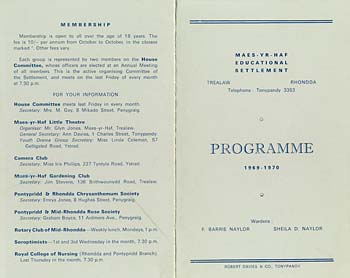 |
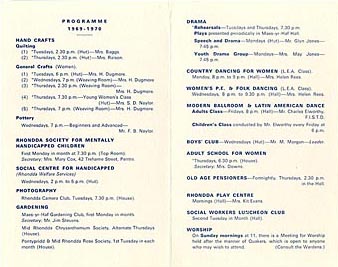 |
The clubs also provided workshops equipped with tools and materials for woodwork, boot-repairing and upholstery as well as all the educational and cultural facilities provided by the Maes-Yr-Haf. These Unemployed Clubs had many fruitful and unexpected consequences, men disillusioned by being unable to find work discovered new skills and a sense of usefulness and community. Women also benefited from instruction on sewing machines, dressmaking and ‘make do and mend',as well as handicrafts such as weaving and pottery. In some districts where permission was given for members to voluntarily work a coal level men delivered 2cwt. of coal per week for each family in the club, as well as to old age pensioners and the disabled in the community. Each club was managed by the club members and provided an invaluable service in the valleys during the ‘Depression Years'. |
| Summer Holidays by the Sea | |
The Society of Friends believed that the unemployed of the Valley benefited from a change of environment and a break away from the everyday ‘ poverty and spiritual depression' suffered by them at that time. Thus the idea of providing each member of the Club with a weeks summer holiday a year, at the seaside, was born. The Society thus secured the use of a disused malthouse at Wick near Cowbridge in the Vale of Glamorgan. The necessary alterations to the building were carried out by the unemployed men themselves and during its time as a holiday centre thousands of families benefited from their break at the seaside. |
An illustration of The Malthouse at Wick |
